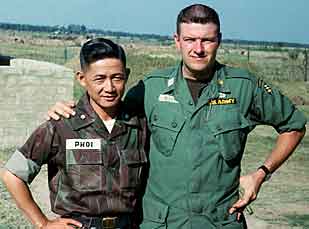 ajor Phoi Van Le is indeed a man among men. A rare combination of military leader, protector of his people, faithful husband, caring father and military advisor to the Hoa Hao Buddhist Central Council, he was first described to me by LTC William Tuttle as being “tougher than nails and a Hoa Hao first and foremost.”
ajor Phoi Van Le is indeed a man among men. A rare combination of military leader, protector of his people, faithful husband, caring father and military advisor to the Hoa Hao Buddhist Central Council, he was first described to me by LTC William Tuttle as being “tougher than nails and a Hoa Hao first and foremost.”
 It was at the time LTC Tuttle, commander of all Special Forces in the IV Military Region of South Vietnam, offered me the command of a TOP SECRET independent warfare mission naming Major Le as my counterpart, that he told me about this combat-proven officer of 18 years wartime service to his people and government.
It was at the time LTC Tuttle, commander of all Special Forces in the IV Military Region of South Vietnam, offered me the command of a TOP SECRET independent warfare mission naming Major Le as my counterpart, that he told me about this combat-proven officer of 18 years wartime service to his people and government.
After explaining to me the fact of our government permitting the enemy safe-havens inside Cambodia (see Part 8 of this series) he told how Major Le had taken this matter of our government aiding and abetting the enemy to the Minister of Defense in Saigon. He demanded the right to carry the war to the enemy no matter where they were so as to protect his people against surprise attacks that were easily mounted by that same enemy from within their Cambodian border sanctuaries.
In my book Expendable Elite – One Soldier’s Journey into Covert Warfare, to be published this spring, I go into great detail about the Hoa Haos of An Phu District, their daily walk and their courage in battle against superior numbers of enemy combatants.
I find it difficult to express in mere words the quality of character that these fine people continually exhibited in every aspect of their lives. There were approximately 64,000 Hoa Haos in the District of An Phu and I can honestly say that we, the men of Special Forces Team A-424, were able to trust each and every one of them to be loyal, honest, faithful to the Hoa Hao religious tenets and courageous to the extreme.
During the seven months that I had the pleasure to be amongst the Hoa Haos of An Phu, we were the first to take the war into what had been enemy safe-havens inside Cambodia and, to the best of my knowledge we did so without harming one Cambodian civilian. We secured the 30 miles of border with Cambodia, cleared an area once held by the enemy inside An Phu and restored the entire district back to its people who were predominantly farmers and fishermen, and did our best to protect them and their lively-hood from the Communist insurgents.
At a time in August 1966 when we, as US Army Special Forces working with the South Vietnamese irregular, paramilitary, and military forces, had brought relative security to the IV Military Region, our government demanded the removal of the very Forces that helped to make it possible to achieve the level of security then in effect. Specifically, in An Phu, and other areas where the Hoa Haos were the predominant defensive force, General Westmoreland, angered at the refusal of the Commanding General of Military Region IV to permit American conventional troops in that area took the unprecedented step of ordering the Saigon Depot commanding officer (I was told this by the deport commander some seven years later) to ignore the needs of the Special Forces in MR IV. We were forced to “borrow” US Navy Landing Craft and raid the depot, using the Bassac and Mekong Rivers as our route to and from Saigon, taking what we needed as the depot personnel stood by, fearing to stop us who wore the Green Beret from taking what we needed, everything being combat essential.
Major Phoi Van Le was trustworthy and loyal, a tactical commander and defensive strategist who I admired and would want to emulate, an officer with sufficient moral courage and wisdom to demand that we, including myself, be tested in combat to see if we “measured up” to the high standards of courage and tenacity they demanded of themselves.
When the Central Intelligence Agency “arranged” to have an ARVN Regiment attack our camp in retaliation for my personal refusal to assassinate Cambodian Crown Prince Norodum Sihanouk, knowing that hundreds of Hoa Hao fighters and countless civilians would be killed or injured, we knew that they had betrayed the Hoa Haos of An Phu and considered them as cannon fodder to appease their appetite for revenge against one American’s actions. I am that one American and understand completely how that act of turning brother against brother that was averted through the courageous intervention of Lieutenant General Quang Van Dang (See Parts11 & 18 of this series) was merely a prelude to the eventual total betrayal by the United States of all of the South Vietnamese people and the abandonment of our promise to protect them from the Communist invaders.
I thank God for the time I had with Major Le and the Hoa Haos of An Phu and I pray that one day their land will be returned to them and their Vietnamese brothers and sisters as a democratic republic.
[Edited by Jeanne Calabretta]